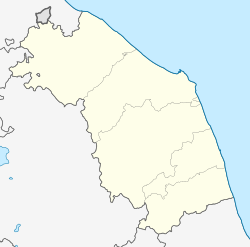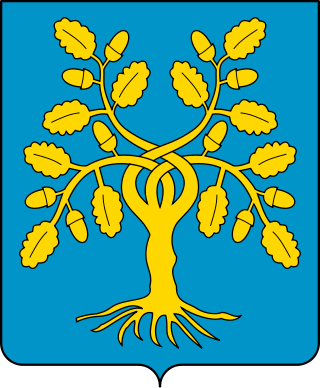
The House of Della Rovere was a powerful Italian noble family. It had humble origins in Savona, in Liguria, and acquired power and influence through nepotism and ambitious marriages arranged by two Della Rovere popes: Francesco Della Rovere, who ruled as Sixtus IV from 1471 to 1484) and his nephew Giuliano, who became Julius II in 1503. Sixtus IV built the Sistine Chapel, which was named after him. Julius II was patron to Michelangelo, Raphael and many other Renaissance artists and started the modern rebuilt of St. Peter's Basilica. Also the Basilica of San Pietro in Vincoli in Rome was the family church of the Della Rovere. Members of the family were influential in the Church of Rome, and as dukes of Urbino, dukes of Sora and lords of Senigallia; the title of Urbino was extinguished with the death of Francesco Maria II in 1631, and the family died out with the death of his granddaughter Vittoria, Grand Duchess of Tuscany.

Piero della Francesca was an Italian painter of the Early Renaissance. To contemporaries he was also known as a mathematician and geometer. Nowadays Piero della Francesca is chiefly appreciated for his art. His painting is characterized by its serene humanism, its use of geometric forms and perspective. His most famous work is the cycle of frescoes The History of the True Cross in the church of San Francesco in the Tuscan town of Arezzo.
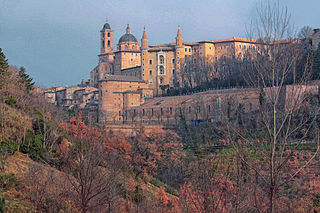
Urbino is a comune (municipality) in the Italian region of Marche, southwest of Pesaro, a World Heritage Site notable for a remarkable historical legacy of independent Renaissance culture, especially under the patronage of Federico da Montefeltro, duke of Urbino from 1444 to 1482.

Federico da Montefeltro, also known as Federico III da Montefeltro KG, was one of the most successful mercenary captains (condottieri) of the Italian Renaissance, and lord of Urbino from 1444 until his death. A renowned intellectual humanist and civil leader in Urbino on top of his impeccable reputation for martial skill and honour, he commissioned the construction of a great library, perhaps the largest of Italy after the Vatican, with his own team of scribes in his scriptorium, and assembled around him a large humanistic court in the Ducal Palace, Urbino, designed by Luciano Laurana and Francesco di Giorgio Martini.

The House of Montefeltro is the name of a historical Italian family who ruled Urbino and Gubbio and became Dukes of Urbino in 1443. The family extinguished in the male line in 1508 and the duchy was inherited by the Della Rovere family.

Fano is a town and comune of the province of Pesaro and Urbino in the Marche region of Italy. It is a beach resort 12 kilometres southeast of Pesaro, located where the Via Flaminia reaches the Adriatic Sea. It is the third city in the region by population after Ancona and Pesaro.

Pesaro is a comune (municipality) in the Italian region of Marche, capital of the province of Pesaro and Urbino, on the Adriatic Sea. According to the 2011 census, its population was 95,011, making it the second most populous city in the Marche, after Ancona. Pesaro was dubbed the "Cycling City" by the Italian environmentalist association Legambiente in recognition of its extensive network of bicycle paths and promotion of cycling. It is also known as "City of Music", for it is the birthplace of the composer Gioachino Rossini. In 2015 the Italian Government applied for Pesaro to be declared a "Creative City" in UNESCO's World Heritage Sites. In 2017 Pesaro received the European City of Sport award together with Aosta, Cagliari and Vicenza.

The Fortress of San Leo is a castle on the border of the Romagna and Marche; the castle is best known as the site where Count Cagliostro died. It was one of the palaces owned by Federico da Montefeltro and his wife Battista Sforza and was a fortified, palatial retreat. It is now a museum.

Girolamo Genga was an Italian painter and architect of the late Renaissance, Mannerist style.

Cagli is a town and comune in the province of Pesaro e Urbino, Marche, central Italy. It is c. 30 kilometres south of Urbino. The Burano flows near the town.

Francesco Maria I della Rovere was an Italian condottiero, who was Duke of Urbino from 1508 to 1516 and, after retaking the throne from Lorenzo II de' Medici, from 1521 to 1538.
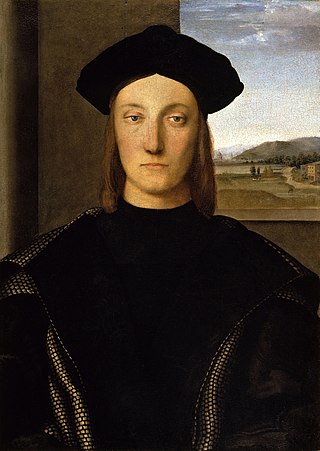
Guidobaldoda Montefeltro, also known as Guidobaldo I, was an Italian condottiero and the Duke of Urbino from 1482 to 1508.

Elisabetta Gonzaga (1471–1526) was a noblewoman of the Italian Renaissance, the Duchess of Urbino by marriage to Duke Guidobaldo da Montefeltro. Because her husband was impotent, Elisabetta never had children of her own, but adopted her husband's nephew and heir, Francesco Maria I della Rovere. She was renowned for her cultured and virtuous life.

Eleonora Gonzaga, Duchess of Urbino (31 December 1493 – 13 February 1570 was Duchess and sometime regent of Urbino by marriage to Francesco Maria I della Rovere, duke of Urbino. She served as regent during the absence of her spouse in 1532.

Giulio della Rovere, also known as Giulio Feltrio della Rovere was an Italian Cardinal of the Catholic Church and a member of the della Rovere family.

Livia della Rovere was an Italian noblewoman of the House of della Rovere and the last Duchess of Urbino (1599–1631).

The Portrait of Guidobaldo da Montefeltro is a picture by the Italian Renaissance artist Raphael, dating from around 1506 and housed in the Uffizi Gallery, Florence. It portrays Guidobaldo da Montefeltro, duke of Urbino.
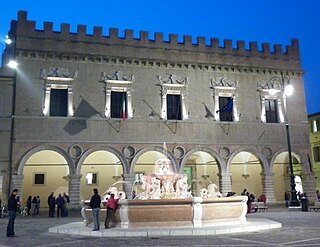
The Palazzo Ducale di Pesaro or Ducal Palace of Pesaro is a Renaissance-style palace in the city center of Pesaro, region of the Marche, Italy.

Vittoria Farnese, also known as Vittoria, Princess of Parma, and by her married name Vittoria Farnese della Rovere, was an Italian noblewoman, Duchess consort of Urbino from 1548 until 1574 by marriage to Guidobaldo II della Rovere, Duke of Urbino.

Sant'Andrea di Suasa is a hamlet of the municipality of Mondavio in the province of Pesaro-Urbino, Italy. The castle-village sits 265 metres above sea level, 23 km from the Adriatic coast and develops along the crest of a large hill to the left of the Cesano river. It is characterized by the mighty wall circuit still intact with a single arch entrance.




